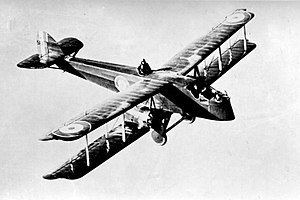Top speed 198 km/h Length 14 m Manufacturer Airco | Wingspan 18 m First flight 1919 Designer Geoffrey de Havilland | |
 | ||
The Airco DH.11 was a British twin-engined biplane bomber which was designed to replace the earlier Airco DH.10 bomber. It was designed to use the unsuccessful ABC Dragonfly engine and was abandoned after the first prototype was built.
Contents
Development
The DH.11 Oxford was designed by Geoffrey de Havilland for the Aircraft Manufacturing Company as a twin-engined day bomber to replace the Airco DH.10. It was designed (as required by the Specification) to use the ABC Dragonfly radial engine which promised to give excellent performance and had been ordered in large numbers to be the powerplant for most of the new types on order for the Royal Air Force. The DH.11 was a twin-engined biplane, with all-wood construction and three-bay wings. It had an aerodynamically clean, deep fuselage occupying the whole wing gap, giving a good field of fire for the gunners in the nose and mid-upper positions.
The first prototype flew in January 1919, powered by two 320 hp Dragonfly engines. The prototype encountered handling problems, and was handicapped by the Dragonfly engines, which were extremely unreliable, being prone to overheating and excessive vibration, while not delivering the expected power. Two further prototypes were cancelled in 1919, with no aircraft in the end being purchased to replace the DH.10.
Variants
Specifications (Oxford Mk I)
Data from Mason, The British Bomber since 1914
General characteristics
Performance
Armament
